Mad Hedge Biotech and Healthcare Letter
February 27, 2024
Fiat Lux
Featured Trade:
(CASHING IN ON CURES)
(LLY), (NVO), (JNJ), (PFE), (MRK), (BIIB)
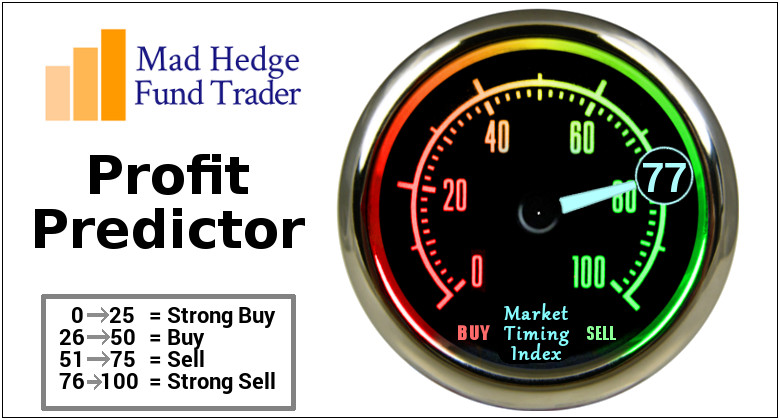
Mad Hedge Biotech and Healthcare Letter
February 27, 2024
Fiat Lux
Featured Trade:
(CASHING IN ON CURES)
(LLY), (NVO), (JNJ), (PFE), (MRK), (BIIB)

In the biotechnology and healthcare industry, reaching a $1 trillion market cap is akin to scaling Mount Everest without oxygen. Yet, Eli Lilly (LLY) has emerged as an unexpected contender, catching the investing world’s attention by not just climbing the mountain but being on the verge of planting its flag at the summit.
A year ago, if you'd whispered in my ear that Eli Lilly's stock was about to skyrocket nearly 140%, I might have choked on my coffee. But here we are, and the buzz isn't just about the rocket ride — it's whether Eli Lilly can be the first biopharma behemoth to hit the $1 trillion market cap. Wild, right?
So, what's cooking at Eli Lilly that's got everyone so revved up? Well, they've got a couple of aces up their sleeve.
Sure, they've been making waves with Verzenio for breast cancer and Jardiance for diabetes, but the real game-changer? Tirzepatide, sold under their brand name Mounjaro for type 2 diabetes and is now strutting the stage as Zepbound for weight loss. This isn't just any old drug; it's the blockbuster that's got everyone from Wall Street to Main Street talking.
But what makes tirzepatide so darn special? It's the first of its kind, a dual GLP-1/GIP agonist, making it a heavyweight champion in the fight against obesity. With sales already blasting past the $5 billion mark in record time, it's like watching a rocket take off without any signs of slowing down.
Now, I know what you're thinking. "But hey, aren't there other big fish in the sea?" Sure, Johnson & Johnson (JNJ), Pfizer (PFE), and Merck (MRK) are doing their thing, but next to Eli Lilly's recent performance, they're looking a bit like they're running in slow motion.
And while Novo Nordisk (NVO) has been gaining traction in the diabetes market with its own version of the treatment, Eli Lilly’s tirzepatide is in a league of its own. In fact, this drug is projected to become the top-selling treatment in history, with the potential to rake in sales north of $25 billion.
For context, AbbVie (ABBV) Humira had an annual record of $21.2 billion, and that’s already the recorded highest-selling therapy in history. But, the road to hitting these goals demands many more new indications.
That’s why it comes as no surprise that tirzepatide is eyeing a new target: metabolic dysfunction-associated steatohepatitis, or MASH for short. It's a fancy way of saying "a really bad liver problem," and it's a growing issue globally.
Beyond tirzepatide, Eli Lilly's expanding in a few other markets. Alzheimer's, for one, where their potential therapy, donanemab, is making waves and presents a potential competitor to Biogen’s (BIIB) Leqembi.
And let's not overlook their recent wins with cancer medicine Jaypirca and ulcerative colitis therapy Omvoh. It's like Eli Lilly's hitting bingo on every card.
With all these in mind, can Eli Lilly truly reach that $1 trillion valuation? With their current market cap already north of $715 billion, it looks like the company is ready to take home the title. Assuming a modest compound annual growth rate of about 7%, that trillion-dollar dream could become reality quicker than you can say "biopharma giant."
As investors, industry watchers, and, frankly, anyone with a pulse on the future of medicine keep their eyes glued to this unfolding story, the message is clear: Eli Lilly is not just about the numbers. It's about setting new benchmarks, pushing boundaries, and cashing in on cures in the most spectacular way possible.
So, if you're wondering where the smart money is heading in the biotechnology arena, following Eli Lilly's trail might just lead you to a treasure trove of opportunities. I suggest you buy the dip.
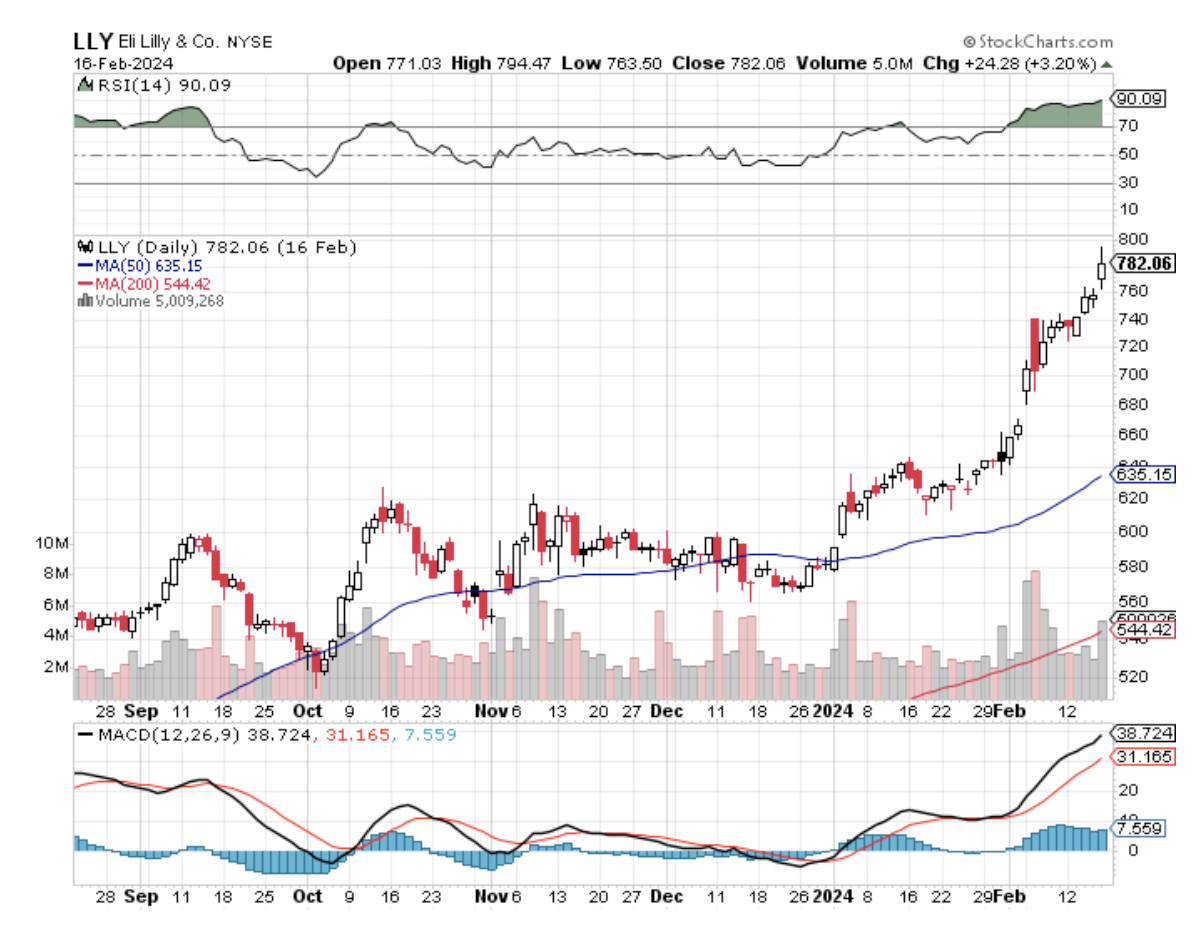
Mad Hedge Biotech and Healthcare Letter
February 15, 2024
Fiat Lux
Featured Trade:
(TACKLING THE BIG C)
(PFE), (BNTX), (BMY), (ABBV), (AZN)
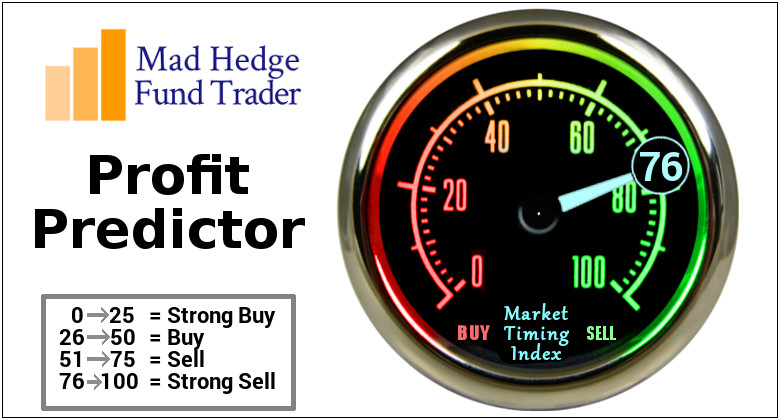
Super Bowl Sunday: not just a day for football fanatics but a golden opportunity for brands to shine brighter than the halftime show, captivating over 100 million pairs of eyes.
Amid the usual suspects of beers, cars, and fizzy drinks, an unexpected name popped up on the screen: Pfizer (PFE). The Big Pharma titan threw its hat in the ring with a multimillion-dollar message that could be summed up as a toast to science itself.
Here’s how Pfizer’s ad went: animated legends of science — from Newton to Einstein, alongside Rosalind Franklin and Katalin Karikó — belting out an ode to medical milestones to the tune of Queen’s “Don’t Stop Me Now.” Add a dash of whimsy with a cameo from penicillin and a crooning tardigrade, culminating in the heartwarming sight of a young cancer survivor leaving the hospital to applause.
This cinematic piece wasn’t just about selling a product; it was about selling a dream, one where science leads the charge against cancer, underscored by Pfizer’s new rallying cry, "Outdo Yesterday," and a nudge towards LetsOutdoCancer.com.
Shrouded in mystery is the exact price Pfizer paid for this 60-second spectacle — shortened from its original 90-second glory.
But, my sources say that the pharma giant shelled out around $6.5 million to $7 million for half that time, making Pfizer’s splurge no drop in the bucket, especially juxtaposed against a recent $15 million pledge to the American Cancer Society.
This grand gesture comes at an important milestone, marking Pfizer’s 175th year and a concerted push to cast a vibrant, forward-looking shadow across its brand, appealing to the public, investors, and its own ranks alike.
After all, it’s an open secret that Pfizer’s looking to weather a storm, with its COVID-19 vaccine sales dwindling.
Despite riding high on the COVID-19 vaccine wave in partnership with BioNTech (BNTX), raking in roughly $57 billion across 2021 and 2022, Pfizer's financial seas have been anything but calm. The stock’s dramatic descent from its late 2021 peak paints a picture of uncertainty, rooted in the sobering performance of its COVID-19 titans, Comirnaty and Paxlovid.
Yet, as we can see, Pfizer’s narrative isn’t one of gloom. Stripping away the pandemic’s shadow reveals a company in robust health, with a 7% operational growth and a record seven FDA nods in 2023 alone.
Speaking of making it rain, Pfizer's not just throwing its COVID-earned billions around for kicks. For example, they've laid down a cool $43 billion on the table to bring oncology biotech Seagen into the fold.
This acquisition isn't your everyday shopping spree either. It's a move designed to transform Pfizer into the leader of the antibody-drug conjugate (ADC) movement in cancer therapy, potentially beating the likes of Bristol Myers Squibb (BMY), AbbVie (ABBV), and AstraZeneca (AZN).
Think of this move as the biopharma eyeing Seagen's $3 billion in 2023 revenue and saying, "Let's crank this up to $10 billion by 2030." Ambitious? Absolutely. But if anyone's got the blueprint to make it happen, it's Pfizer.
The pivot to cancer isn’t just a strategic shift but a play for the heartstrings of a global audience. With cancer touching lives universally, Pfizer’s Super Bowl gambit seeks to transcend its COVID-19 narrative, aiming for a connection that’s both deeper and more universal. The deliberate omission of its vaccine from the ad speaks volumes, aiming to bridge divides in a viewership as diverse as the Super Bowl’s.
Still, the true measure of its Super Bowl splash — beyond the ad’s immediate sparkle — may lie in subtler indicators, from stock movements to talent retention and a potential surge in interest around its cancer-fighting mission.
Whether this move translates into a long-term win for Big Pharma titan remains to be seen, but for now, the spotlight isn’t just on the Chiefs’ victory but on Pfizer’s leap into the hearts and minds of millions, championed by science and the indomitable spirit of innovation. I suggest you buy the dip.
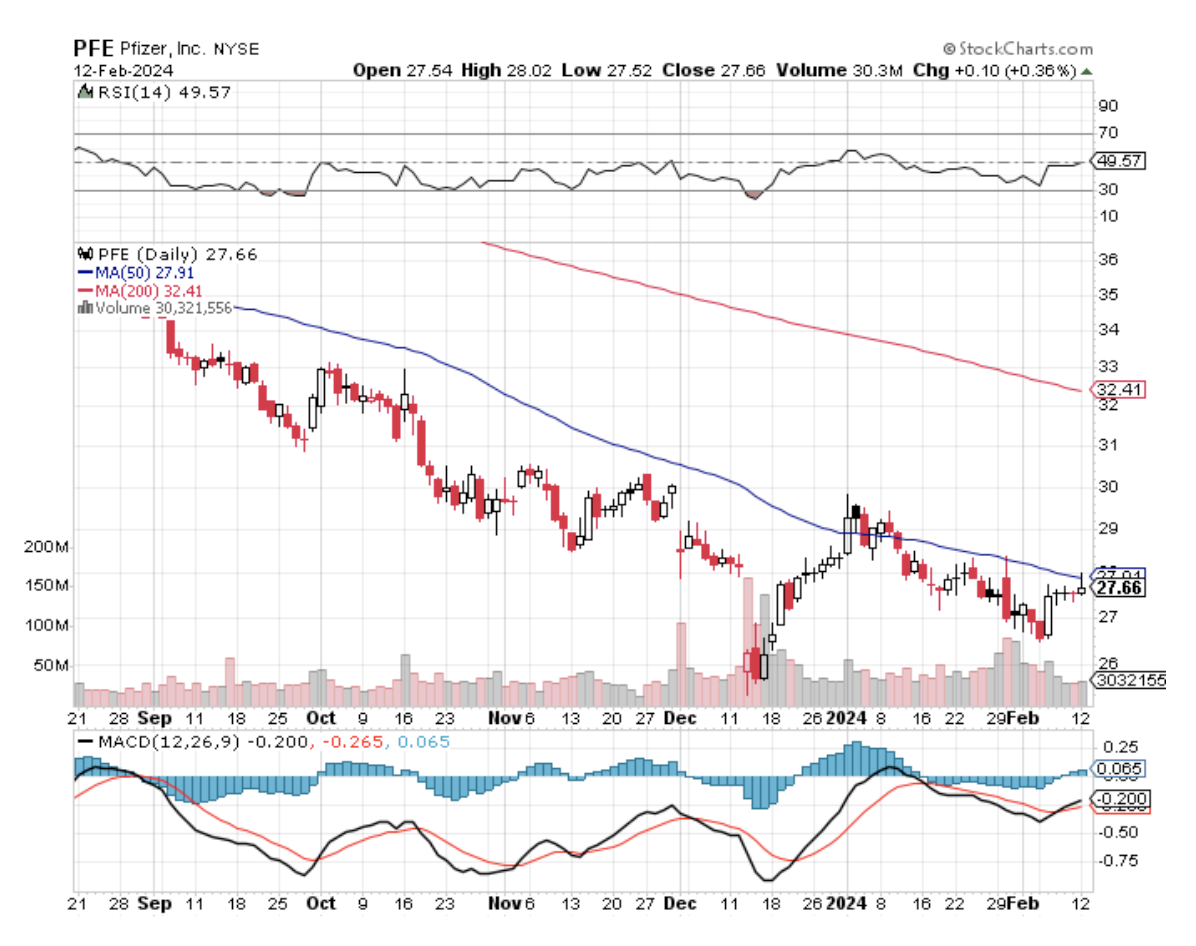
Mad Hedge Biotech and Healthcare Letter
February 6, 2024
Fiat Lux
Featured Trade:
(SETTING THE TABLE FOR STEADY GAINS)
(ABBV), (ABT), (PFE), (GILD), (DNA), (MRNA), (AMGN), (LLY)
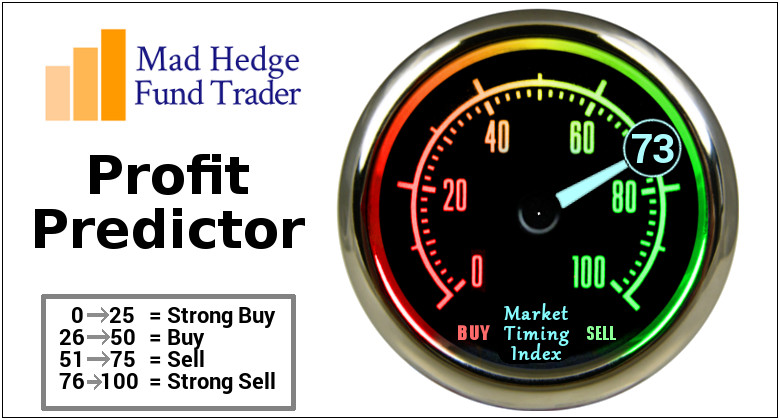
Here's a nugget of wisdom from someone who's sailed the investment waters more times than I've had hot dinners: diversification is your best friend. Think of it as the Swiss Army knife in your investment toolkit.
Now, if there's one treasure you'd want aboard your investment ship, it's a dividend stock. Not just any old stock, though. I'm talking about AbbVie (ABBV).
Since it waved goodbye to its parent company, Abbott Laboratories (ABT), in 2013, it has boosted its dividend payouts by an eye-popping 290%. With a yield hanging around 4% and delivering a 130% total return over the past 5 years, long-term investors undoubtedly struck gold.
Unfortunately, 2023 has turned into the kind of year we'd rather forget. The end of Humira's patent was looming like a dark cloud, threatening to rain on AbbVie's parade by letting generics flood the market. The horror, right?
But, plot twist: the anticipated disaster was more of a light drizzle. Despite the competition, Humira still brought in a cool $11.1 billion. Sure, it's a dip, but not the plunge we feared.
Meanwhile, AbbVie's been on a shopping spree, snapping up Immunogen and Cerevel for a combined total that's a smidgen under $19 billion. It's like they're collecting Infinity Stones, diversifying beyond Humira into areas ripe with potential.
And let's not forget their foray into the realm of Antibody Drug Conjugates (ADCs) — the hot ticket in oncology.
While AbbVie’s not throwing around cash like confetti, like some of their peers including Pfizer (PFE), Gilead Sciences (GILD), Genentech (DNA), they're making notable moves. It's a bit like betting on the dark horse; if their ADCs and CNS ventures hit their stride, we're all in for a treat.
Amidst all this innovation and expansion, AbbVie hasn't lost sight of what gets investors' hearts racing — a solid dividend. It's the kind of steady reliability that's as comforting as your favorite cozy blanket.
As if those aren’t enough, the company just threw us a curveball that's got Wall Street buzzing more than my neighbor's annoying leaf blower on a peaceful Sunday morning.
In its recent earnings report, AbbVie not only beat the revenue expectations for its fiscal fourth quarter but decided to sweeten the deal by raising its long-term sales outlook.
Despite the concerns about Humira, AbbVie still posted fourth-quarter earnings that had their investors nodding in approval, even if they were a tad lower than previous years’ glory days. With revenue hitting $14.3 billion, surpassing the street's guess of $14 billion, it's clear the company isn't just hanging in there; it's throwing punches back.
The immunology portfolio, while taking a 12% hit, isn't down for the count, thanks to Skyrizi and Rinvoq. These two rising stars, which are quickly becoming the Batman and Robin of the biopharmaceutical world, are not just filling Humira's big shoes; they're sprinting.
With the duo’s sales surging by 52% and 63%, respectively, it's no wonder AbbVie is adjusting its binoculars and raising its long-term guidance for these drugs to a whopping more than $27 billion by 2027.
That's a $6 billion jump from their previous forecast. If that doesn't scream confidence, I don't know what does.
And just for a bit of perspective, while AbbVie was basking in the glow of success, its peers had a mixed day at the market. Pfizer took a slight tumble, Moderna (MRNA) and Amgen (AMGN) dipped their toes into the red, while Eli Lilly (LLY) floated up, riding a wave of optimism.
So, as we move forward this 2024, you might be wondering, "What's next for AbbVie?"
Well, if I were a betting man (and let's be honest, investing is betting with extra steps), I'd say we're not likely to see AbbVie pulling a rabbit out of a hat.
But, and it's a big but, we're talking about a company that's as expertly managed as a Michelin-starred kitchen. They've got a knack for serving up share price growth and dividends that leave investors coming back for seconds.
So while AbbVie might not be dangling the next blockbuster breakthrough in front of us, their steady march forward is as promising as finding a shortcut on your morning commute. We might not see the stock skyrocket overnight, but a climb to around $180 per share? That's not just possible; it's on the menu. And right now, with its recent earnings report, it's as good a time as any to pull up a chair to the AbbVie table. Bon appétit.
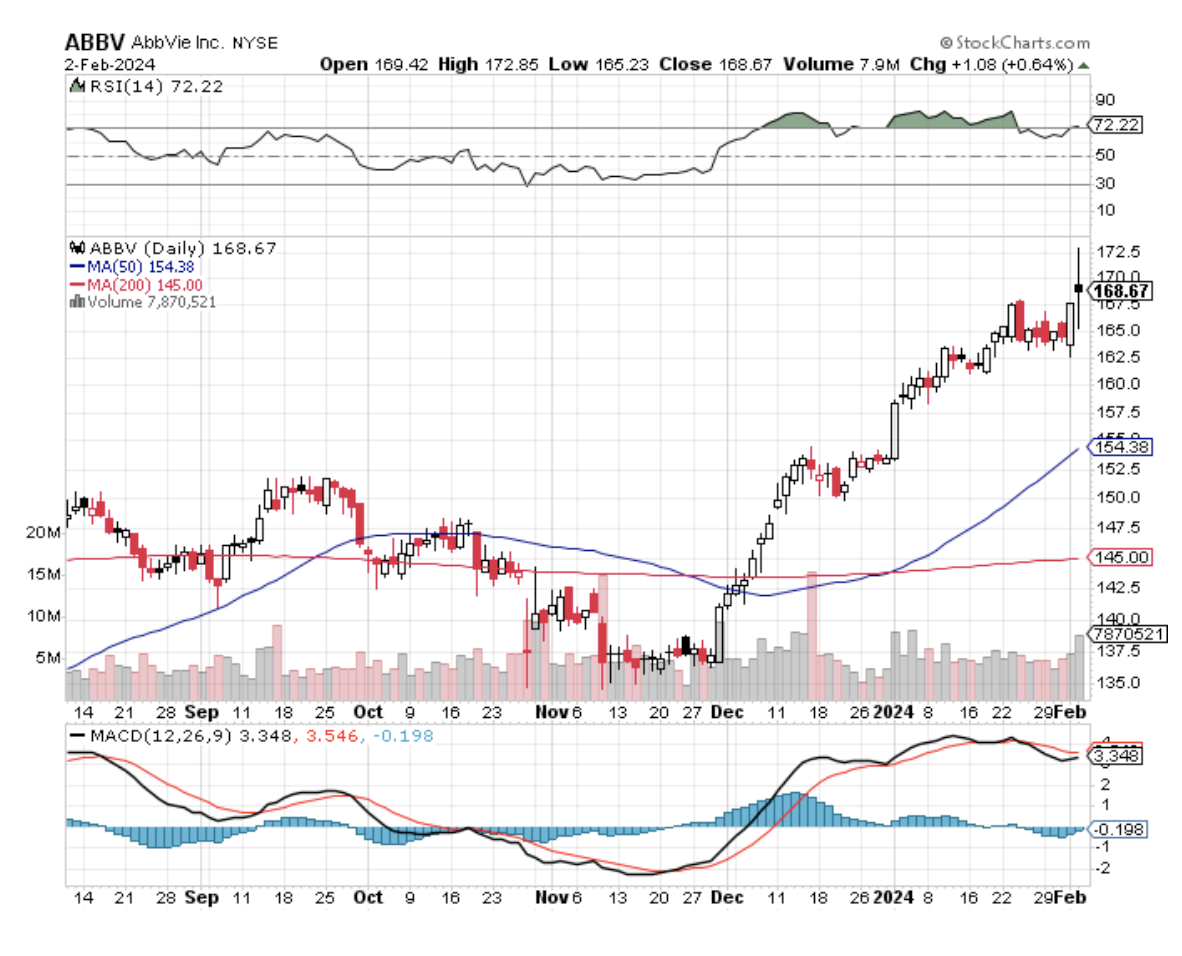
Mad Hedge Biotech and Healthcare Letter
January 30, 2024
Fiat Lux
Featured Trade:
(BRAIN GAINS)
(BIIB), (ESALY) (LLY), (REGN), (ALNY), (MRK), (AMGN), (PFE), (BMY)
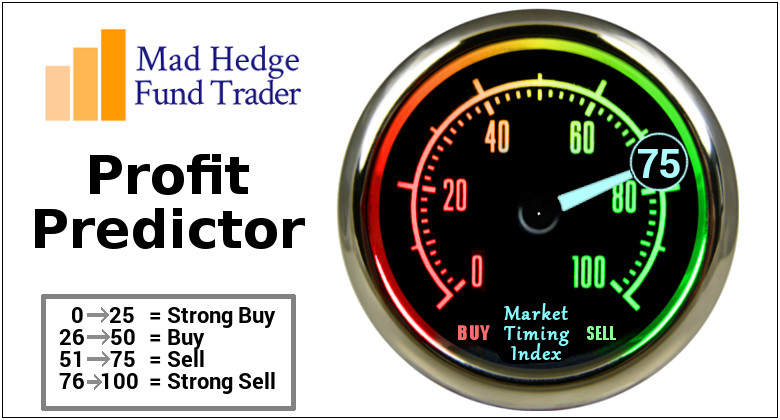
Let's talk about a golden opportunity knocking at our doors – the booming market of Alzheimer's disease treatments in biopharma. We're not just talking about a small uptick here. With a slew of new meds on the horizon, this market is gearing up for some serious growth, and you might want to grab a piece of this pie.
The dominant name on our radar is Biogen (BIIB), ticking at $260 per share with a market cap that's flirting with $39 billion.
Now, with a solid $10 billion in sales and trading at a nifty 16 times its 2024 estimated earnings, Biogen's got some serious mojo. I've been eyeing it since last year, but boy, have things changed since then.
A critical game-changer was Chris Viehbacher, the new CEO since November 2022. He's already played a couple of aces – slicing $800 million in costs (which, by the way, could pump up earnings by $5 a share by 2025) and wrapping up the acquisition of Reata Pharmaceuticals in September 2023.
This new addition to Biogen’s portfolio has a hot ticket item, Skyclarys, for treating Friedreich’s ataxia. It's a rare find, but it could add a cool $5 per share in earnings in a few years.
But the most exciting name in Biogen’s arsenal is Leqembi, the company’s Alzheimer’s treatment. They're splitting the pot with Eisai (ESALY), and this drug is a little like turning back the clock on cognitive decline – think a two-year rewind button.
The big bucks talk here: we're eyeballing $2 billion in revenue by 2028 and maybe a whopping $4 billion by 2033. And hey, there might even be more where that came from.
Let's chew on a few things here. Biogen has the potential to snag a 60% market share against Eli Lilly’s (LLY) donanemab – the only worthy opponent in the market so far. And given Leqembi's safety creds, this might be playing it safe.
Aside from Eli Lilly, there’s Roche (RHHBY), with candidates in Phase 2 and Phase 1 trials, but they're not quite hitting the jackpot yet. As for other competitors in the space like Regeneron (REGN) and Alnylam (ALNY)? Well, they're cooking up something different in Phase 1, but it's a bit early to call.
Meanwhile, Biogen's got another trick – a home-use version of Leqembi coming this fall. And get this: doctors are buzzing about nipping Alzheimer’s in the bud, way before it crashes the party. Imagine getting a jab of Leqembi as part of your routine check-up when you're only 50. If this works, then we could be kissing Alzheimer’s goodbye by 2040.
For the longest time, Biogen was like that one-hit wonder with its multiple sclerosis treatments. But now, they're swinging for the fences with the largest unmet health need out there. If Leqembi hits it big, and I mean really big, we could be talking about sales far beyond that $4 billion mark by 2033.
But let's not get ahead of ourselves. The big pharma world is about to hit a few speed bumps with a wave of patent cliffs from 2025 to 2029. That’s a headache for the likes of Merck (MRK), Amgen (AMGN), Pfizer (PFE), and Bristol Myers Squibb (BMY).
Biogen, though, is sitting pretty with two growth products and a pipeline that’s got pizzazz. Plus, they're a hot catch for any big pharma looking for a dance partner without stepping on regulatory toes.
As we roll into the next decade, keep your eyes peeled for investment opportunities popping up like daisies. And don't feel like you've got to jump on the first bandwagon that rolls by. This market's just stretching its legs, and today's champs might just be tomorrow's old news.
So, what's the smart play here? Spread your bets across a few horses in the Alzheimer's race, and make sure they're not one-trick ponies.
Eli Lilly, for instance, is more than just an Alzheimer's bet – they're making waves in diabetes and soon, obesity treatments. Biogen, despite its Alzheimer's experience, is a bit of a gamble, especially after its first drug's rocky start.
Remember, investing in Alzheimer's treatments now is like catching the early wave – it's riskier, sure, but the potential for a big payoff is there. This is an emerging market, and it's revving up for an exciting ride. I suggest you add these names to your watchlist.
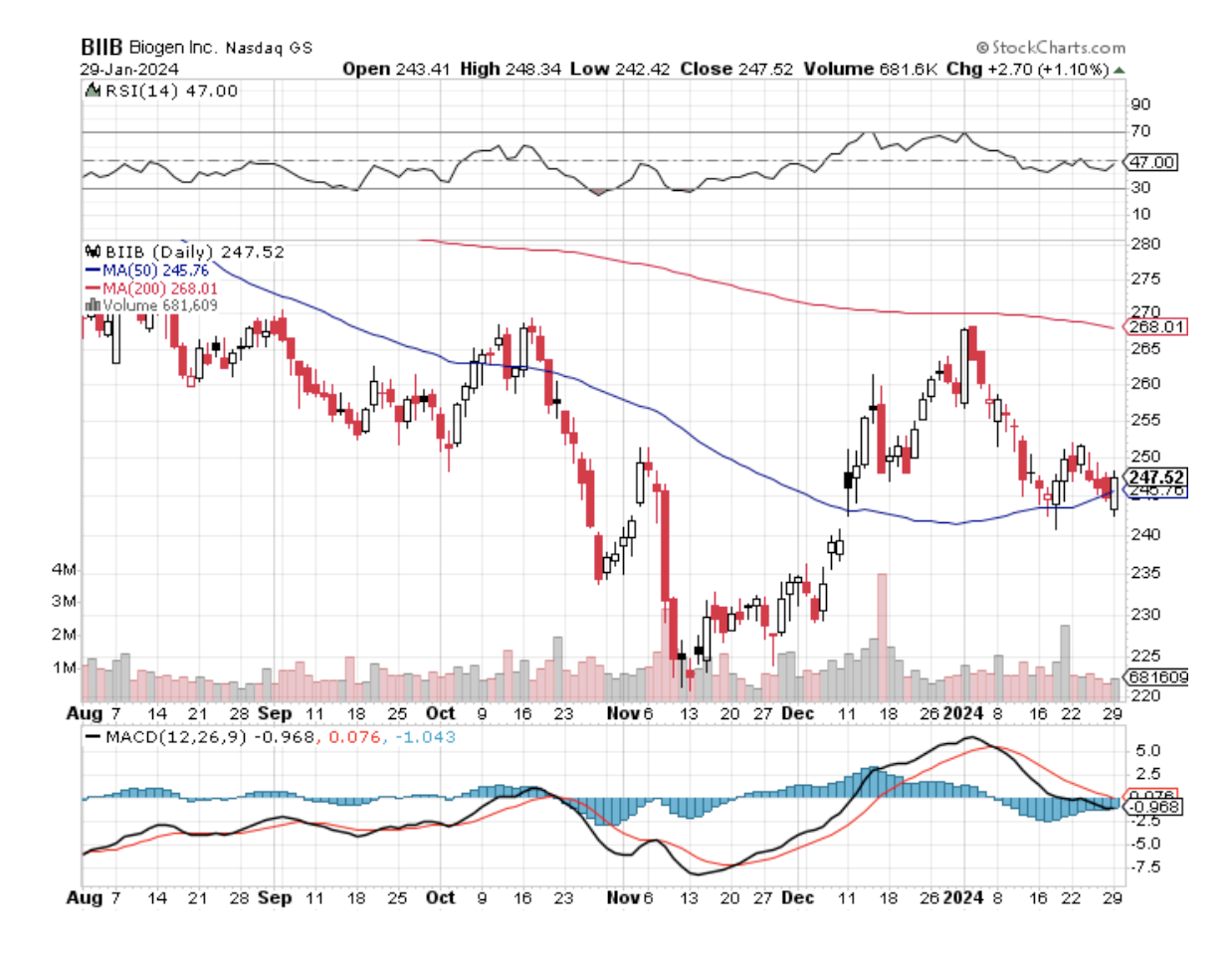
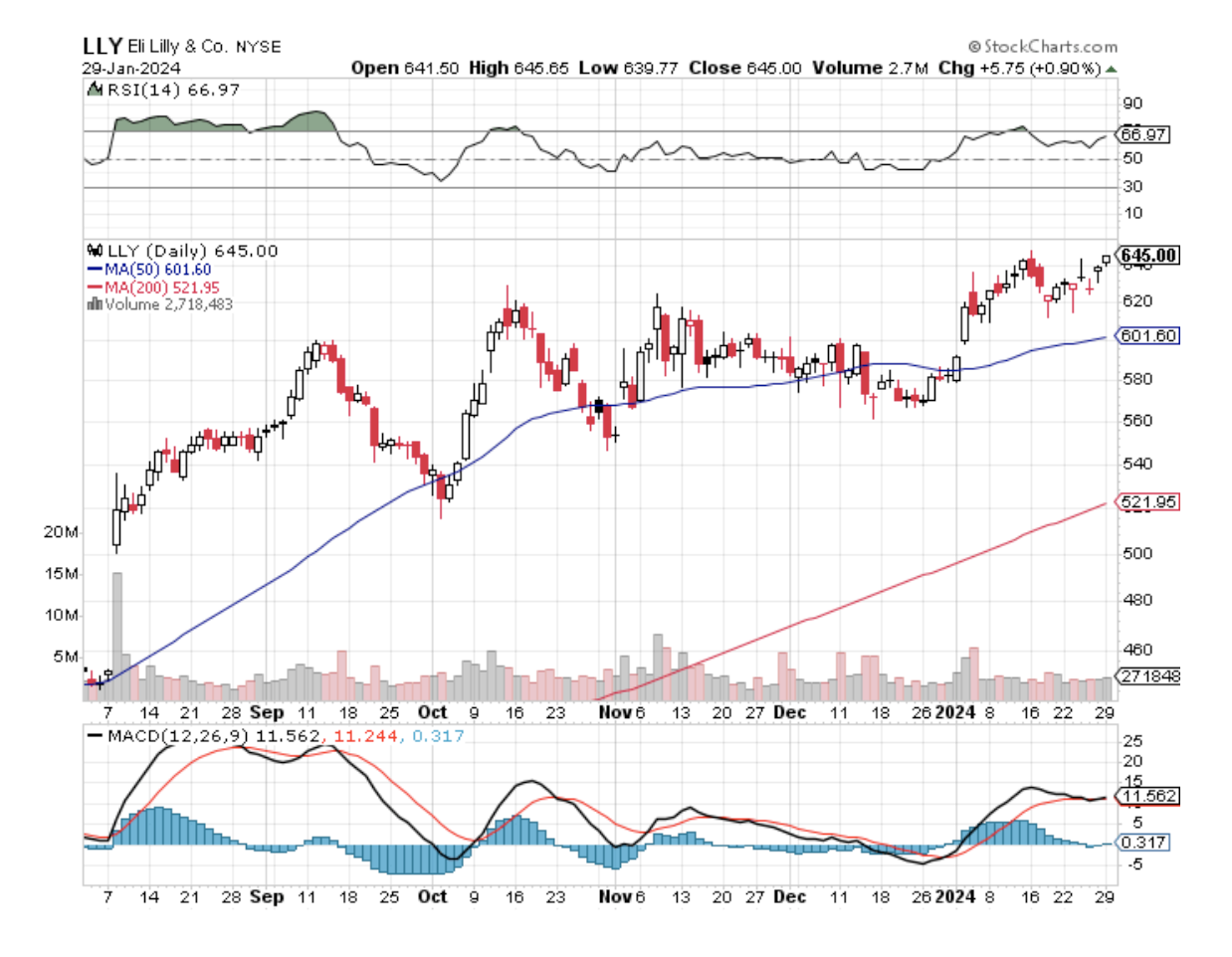
Mad Hedge Biotech and Healthcare Letter
January 23, 2024
Fiat Lux
Featured Trade:
(PHARMA'S AI PLAY: A MASTERSTROKE OR MISFIRE?)
(AZN), (ILMN), (NVDA), (SDGR), (EXAI), (SNY), (BAIVF), (SNY), (GOOGL), (PFE), (IBM), (NVS), (BAYR), (RHHBY), (VRTX), (JNJ)

Faced with an aging blockbuster pipeline and a competitive landscape where some of its rivals are sprinting ahead, AstraZeneca (AZN) is making a bold move - doubling down on Artificial Intelligence (AI).
This isn't just about keeping up with the Joneses (or in this case, their industry rivals); it's a calculated gamble with the potential to redefine drug discovery. The million-dollar question is: will this tech-savvy move send its shares soaring or just keep it in the running?
Let's address the elephants in the room of drug development. It's a long and winding road, with more dead ends than a maze in a horror movie. The usual grind? Spend ages finding a glimmer of hope in therapy targets and molecules, only for a paltry 21% to get the regulatory thumbs up after clinical trials.
So, you can bet your bottom dollar that if there’s a technology promising to up those odds and speed things up, companies will be jumping on the bandwagon faster than you can say "biotech boom."
And AstraZeneca? They are fully committing to AI, making significant waves in the field.
Case in point: their recent team-up with Absci, an AI drug discovery outfit. They're talking about developing a cancer-fighting antibody, with a potential payout of up to $247 million in milestone payments. If this pans out, it could be the first of many high-fives between the two.
But AstraZeneca's history with AI extends beyond this collaboration. Last September, they put up to $840 million on the line with Verge Genomics, aiming to tackle neurodegenerative diseases.
Add to that their work with Illumina (ILMN) and Nvidia (NVDA) in 2021 for some supercomputing firepower, and you've got a company that's serious about its AI game. They’ve even got a couple of AI-bred candidates in their pipeline, though it’s hush-hush on how those are faring.
And before you think it’s all about the new kids on the block, AstraZeneca has been rubbing elbows with Schrodinger (SDGR) since before 2020, working on making their biological medicine modeling sharper than a tack.
However, AstraZeneca is far from being the lone ranger in this new frontier.
Exscientia (EXAI) and Sanofi (SNY) are pairing up to take on COPD with an AI-driven approach. Meanwhile, BenevolentAI (BAIVF) played matchmaker between baricitinib and its new role as a COVID-19 treatment contender.
Over at Google’s (GOOGL) DeepMind, they’ve cooked up AlphaFold, an AI program adept at unraveling protein structures – a feat that’s akin to finding a map to hidden treasure in drug design.
And let's not forget the big guns. Pfizer (PFE) has teamed up with IBM’s (IBM) AI and supercomputing prowess, a partnership that’s been pivotal in accelerating the development of COVID-19 treatments like Paxlovid.
Novartis (NVS) is another key player, wielding AI to shave years off its drug development timeline, a strategy that could redefine the pace of pharmaceutical innovation.
Not to be outdone, Roche (RHHBY) is utilizing AI for a spectrum of tasks, from target identification to the virtual screening of molecules, illustrating the technology’s versatility in the drug discovery process.
Bayer (BAYRY) is also making a significant bet on AI to uncover new therapies, focusing on areas like immuno-oncology and cardiovascular diseases, areas with immense potential for groundbreaking treatments.
Vertex Pharmaceuticals (VRTX) and Johnson & Johnson (JNJ) are part of this evolving landscape as well, leveraging AI to enhance various stages of drug development. Their involvement underscores the widespread adoption of AI across different phases of the pharmaceutical process, from initial research to clinical trials.
Now, let’s go back to AstraZeneca. Best-case scenario? They cut their R&D budget, which was a cool $9.8 billion in 2022 while keeping the pedal to the metal on their clinical trials.
Worst case? Their AI bets don't pay off big time. But let's be real, with AI tech moving faster than a New York minute, that's looking less and less likely.
So, should you invest in AstraZeneca stocks right now? Not so fast. Jumping on the AI bandwagon isn't a golden ticket on its own.
Remember, everyone and their mother in big pharma is chasing the same AI dream. For now, it’s a case of watch, wait, and see how this fusion of AI and pharmaceuticals reshapes the landscape of drug discovery and development. Keep your ears to the ground – this is one race you don't want to miss.
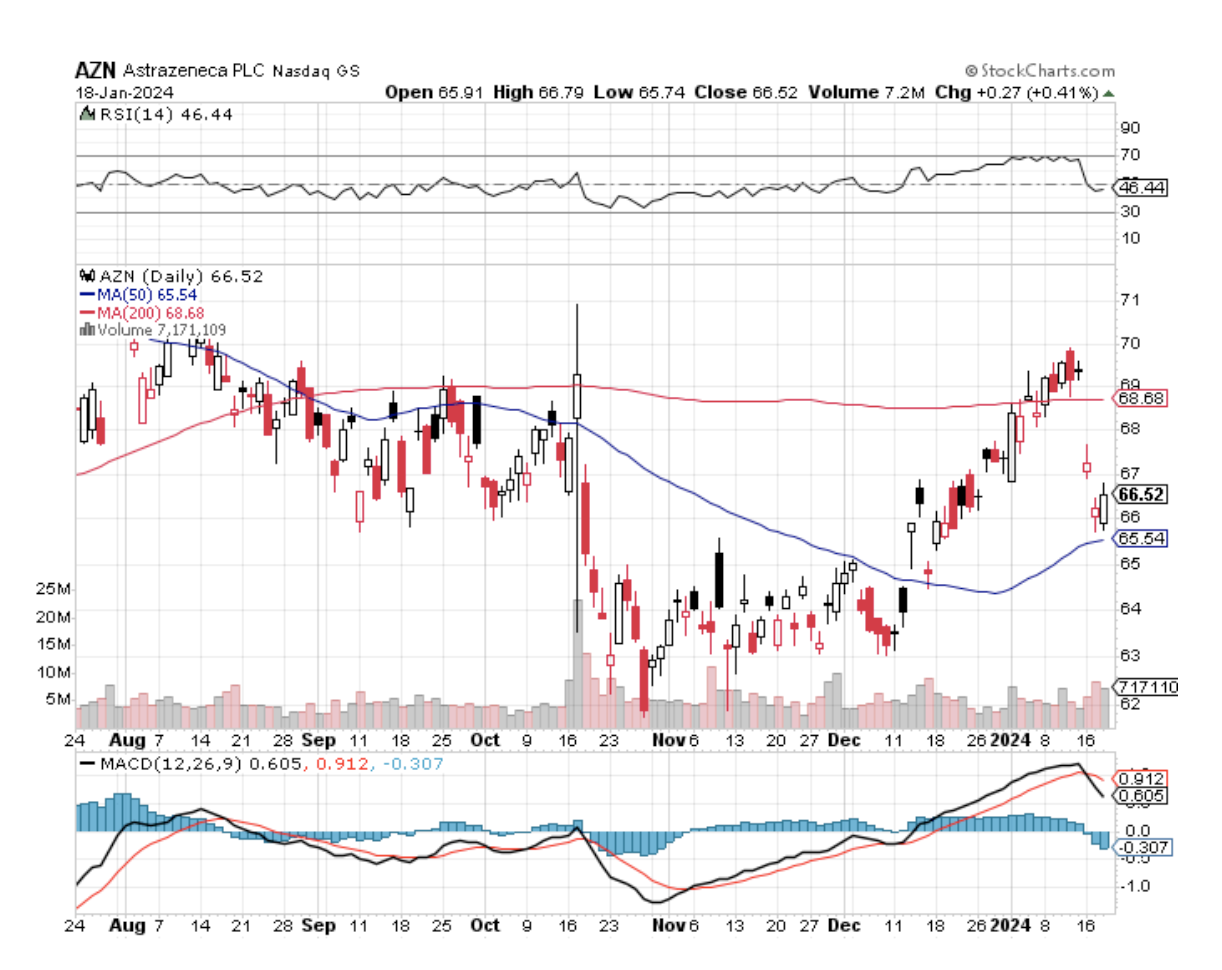
Legal Disclaimer
There is a very high degree of risk involved in trading. Past results are not indicative of future returns. MadHedgeFundTrader.com and all individuals affiliated with this site assume no responsibilities for your trading and investment results. The indicators, strategies, columns, articles and all other features are for educational purposes only and should not be construed as investment advice. Information for futures trading observations are obtained from sources believed to be reliable, but we do not warrant its completeness or accuracy, or warrant any results from the use of the information. Your use of the trading observations is entirely at your own risk and it is your sole responsibility to evaluate the accuracy, completeness and usefulness of the information. You must assess the risk of any trade with your broker and make your own independent decisions regarding any securities mentioned herein. Affiliates of MadHedgeFundTrader.com may have a position or effect transactions in the securities described herein (or options thereon) and/or otherwise employ trading strategies that may be consistent or inconsistent with the provided strategies.
This site uses cookies. By continuing to browse the site, you are agreeing to our use of cookies.
OKLearn moreWe may request cookies to be set on your device. We use cookies to let us know when you visit our websites, how you interact with us, to enrich your user experience, and to customize your relationship with our website.
Click on the different category headings to find out more. You can also change some of your preferences. Note that blocking some types of cookies may impact your experience on our websites and the services we are able to offer.
These cookies are strictly necessary to provide you with services available through our website and to use some of its features.
Because these cookies are strictly necessary to deliver the website, refuseing them will have impact how our site functions. You always can block or delete cookies by changing your browser settings and force blocking all cookies on this website. But this will always prompt you to accept/refuse cookies when revisiting our site.
We fully respect if you want to refuse cookies but to avoid asking you again and again kindly allow us to store a cookie for that. You are free to opt out any time or opt in for other cookies to get a better experience. If you refuse cookies we will remove all set cookies in our domain.
We provide you with a list of stored cookies on your computer in our domain so you can check what we stored. Due to security reasons we are not able to show or modify cookies from other domains. You can check these in your browser security settings.
These cookies collect information that is used either in aggregate form to help us understand how our website is being used or how effective our marketing campaigns are, or to help us customize our website and application for you in order to enhance your experience.
If you do not want that we track your visist to our site you can disable tracking in your browser here:
We also use different external services like Google Webfonts, Google Maps, and external Video providers. Since these providers may collect personal data like your IP address we allow you to block them here. Please be aware that this might heavily reduce the functionality and appearance of our site. Changes will take effect once you reload the page.
Google Webfont Settings:
Google Map Settings:
Vimeo and Youtube video embeds:
